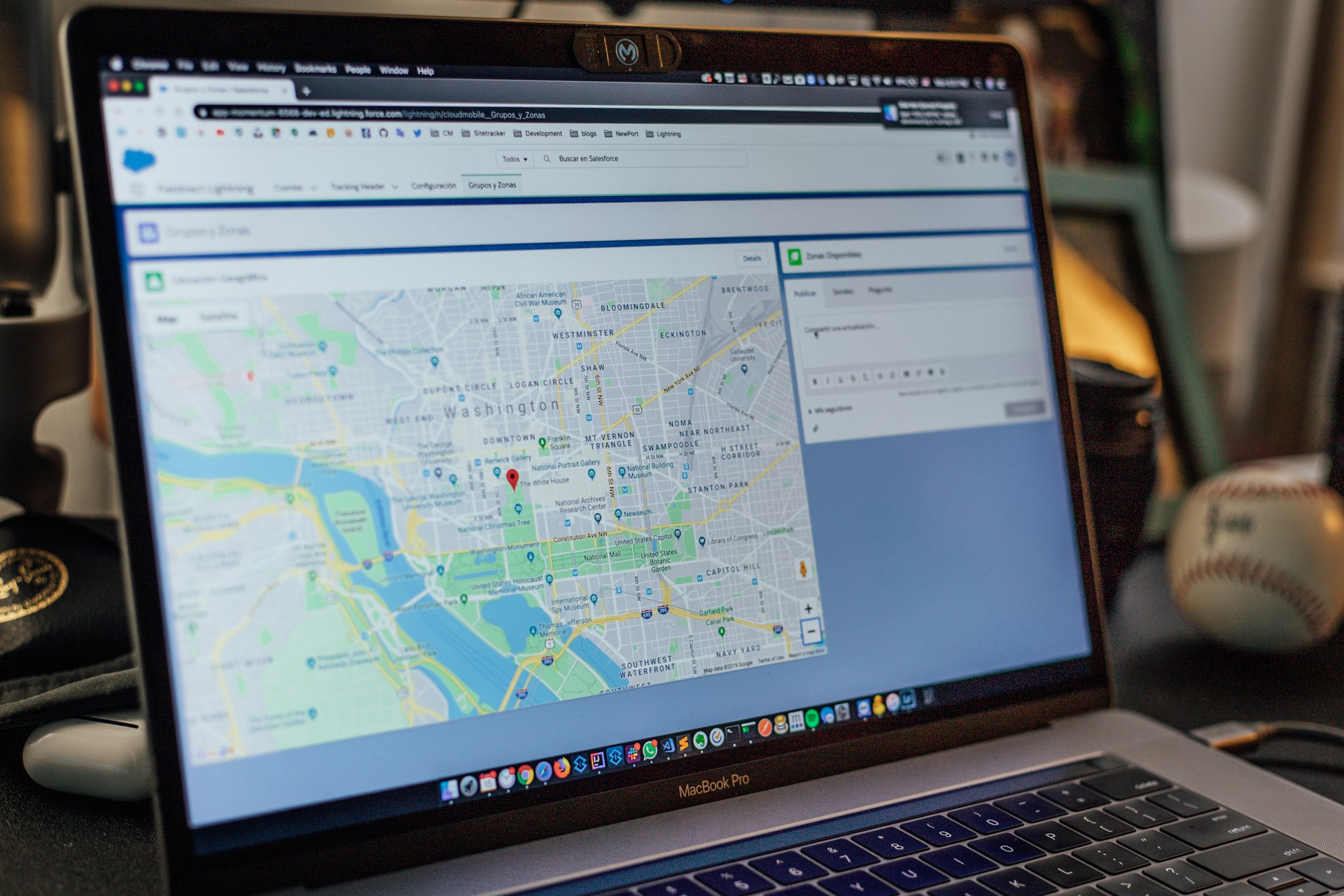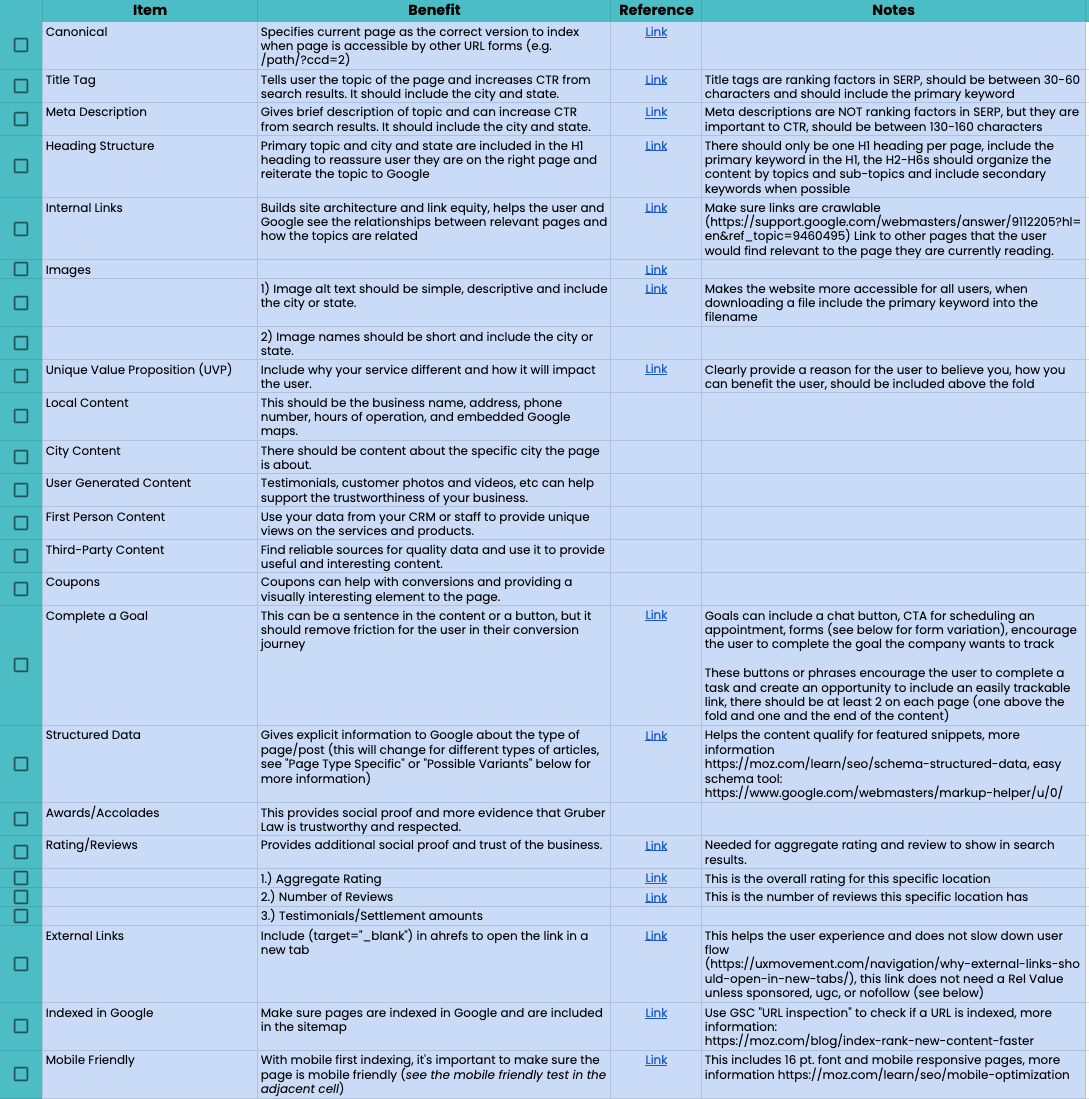Location pages improve the visibility and rankings of geo-specific keywords for businesses with physical locations or service territories. Done well, they provide search engines and users with a better understanding of the services you provide and where you provide them.
But there’s a glaring problem with most landing page efforts in local SEO.
Everyone’s location pages kinda suck.
The good news is they don’t have to, and it’s not that difficult to produce local landing pages at scale that actually add value to the world.
We’ll explore a few common problems with local landing pages and provide you with a checklist to make sure your location pages don’t suck (wink).
✅ Just wanna head straight to the checklist? Grab it here.
Common Problems with Location Pages
Location pages across business types and sizes often suffer from the same maladies.
- Duplicate content: Finding and replacing the city and state is not a good strategy for local landing pages. Location pages should include content that’s specific to the locale and service being targeted, not generic boilerplate to fill an arbitrary word count.
- Doorway pages: Let’s face it: local landing pages are often primarily for search engines. But that doesn’t mean they must lack value and be reduced to doorway pages. You can provide value for users and get some organic traffic from search engines with properly optimized, locally flavored landing pages.
- Low user engagement: Local landing pages can work in search results without actually leading to conversions. The content on local landing pages must contribute to the buyer’s journey and include clear CTAs and satisfactory UX to move from clicks to conversions.
- Thin content: The struggle to create unique content for the same services across locations can lead to low content and page quality, limiting success with users and search engines.
All of these common problems point to one core issue: scalability. Producing content and pages for several locations—a few or a few hundred—is challenging to execute at scale.
Remember, though, that poorly produced local landing pages will get you nowhere fast. Following the best practices outlined in the list below (and slowing down a little, if necessary!) will lead you toward local landing page success.
Elements to Include for Local Landing Page Success
We surveyed search engine results pages for various home services in the 50 largest US cities to determine what location pages need for maximum success. We’ve distilled the most important insights into a list for you, but there are a few overarching themes to point out before we dig into the nitty gritty.
First, content quality matters more than quantity. The race isn’t to have the most content but the best. You might be tempted to generate location pages at scale using templates and AI, but we strongly recommend you find a balance between scalability and quality if you intend to draw clicks and customers.
Second, notice what your competition is doing. If you’re in a more competitive market, you’ll likely find many of the best practices below being implemented. Take note of what’s working best in your market, and put in the effort to exceed what’s already ranking. If you’re in a less competitive market, you might be the one to establish local landing page best practices in your field and territory.
With those two principles in place, let’s get into the details.
Here’s the list of what we recommend you include and consider to maximize the effectiveness of your local landing pages for users and search engines
✅ Want your own copy of the complete local landing page checklist? Get it here.
URL Structure
Use descriptive words in your URL paths. Google itself recommends it. Depending on your existing site structure and the goal of your landing pages, you may want to include the target service, location, or both in your URLs.
Canonical Tag
Canonical tags specify the correct version Google should index when the same or similar content is available via other URL forms (for example, /path/?ccd=2). Deploying canonical tags will ensure that your content is “deduplicated” to avoid cannibalization in search results.
Title Tag
Title tags tell users and search engines about a page’s topic. A catchy title tag element can increase your clickthrough rate (CTR). Title tags are a ranking factor, so be sure to optimize yours with your primary keyword and the city and state you are targeting with your local landing page.
Meta Description
Meta descriptions do not directly influence search rankings, but they can help with CTR, which influences your rankings indirectly (or directly, depending on who you ask). Include the city and state you are targeting.
Heading Structure
Headings provide an outline for your users and help search engines understand a page’s content. You should utilize a single H1 that includes your content’s primary topic and city and state. H2–H6 headings should organize your content by topics and sub-topics and naturally include secondary and related keywords where possible.
Internal Links
Internal links help users and search engines understand the relationships between relevant pages and the relationships between topics on your site. Link only to relevant and useful content for users, and ensure your links are crawlable. Internal links can also pass link equity, improving your search rankings.
Images
Use simple, descriptive alt text for your images, including your target city or state. Image names should be short and include the city or state.
Unique Value Proposition (UVP)
Explain why your service is better for users. Why should they choose you over your competitor down the street or across town? Include UVP content above the fold if possible.
Local Content
Include your business name, address, phone number, and hours of operation, and consider embedding a map that links to your Google Business Profile. You can locate the embed code by clicking Share and Embed a map on your GBP.
City Content
Your content, both visual and text, should reflect the city you are targeting. Your users probably don’t need a history lesson on your target locale, but they will benefit from content that accurately reflects the region.
User Generated Content
Testimonials and customer photos or videos can help support your business’s trustworthiness. UGC content also leaves visitors with the impression that your business is regularly patronized, encouraging prospective customers to make contact.
First-Person Content
Use data from your CRM or staff to provide unique views on your services and products. What questions can you answer that you won’t find in a third-party keyword research tool?
Third-Party Content
Find reliable sources for quality data and use them to provide useful and interesting content.
Coupons
Coupons can increase the likelihood of your users converting. Including unique, time-based promotions can help users understand the offer’s scarcity and take action sooner.
Complete a Goal
Encourage users to complete a goal you want to track. Goals can include a chat button, CTA for scheduling an appointment, forms, and more. Include at least two on each page, one above the fold and one toward the end of the content.
Structured Data
Structured data markup gives Google information about the type of content you are offering. In addition to search engines better understanding your content, your pages can quality for rich results that can help you stand out in search results to improve your CTR.
Awards/Accolades
Any social proof you can provide for your business that’s not just self-assertion is a win for your credibility and trustworthiness in the eyes of your customers. Maybe you feel like you’re tooting your own horn too much, but prominently displaying your accolades can draw more leads and conversions.
Reviews/Testimonials
Online consumers are increasingly savvy and regularly investigate reviews from multiple sources. If you provide them with some street cred up front, you’re already one step ahead. Perhaps you embed a video testimonial and include some text review content that links back to the platform you sourced the review from, likely your GBP. However you display your customer-generated social proof, reviews will reassure your customers and make them more likely to convert.
External Links
Similar to third-party content above, link out to trustworthy sources that are topically and locally relevant. Outbound links may not be a ranking factor per se, but anything you can do to improve UX and demonstrate context for Google is bound to help you. Just don’t forget to have those outbound links open in a new tab!
Indexed in Google
Indexation is basic—until you realize Google never picked up your page. You can use Google Search Console (GSC) to ensure that the pages you need indexed are, indeed, indexed. If you’re publishing new local landing pages or updating existing ones, use the URL inspection tool to request indexing. Fetching the URL in GSC gives your new content the best chance of getting indexed sooner.
Mobile Friendly
Since 2016, Google has prioritized mobile-first indexing, so mobile-friendliness is key to the performance of your local landing pages. Ensuring your pages are responsive, legible, and interactive on smaller viewports will help your users and please search engines. You can use Lighthouse to help assess your mobile friendliness.
Page Speed
Faster page speed and load times on your local landing pages increase user satisfaction and conversions. Minimizing interruptions to your pages’ interactivity will help users accomplish what they need to and impress search engines. You can use PageSpeed Insights to help assess your speed.
Content Above the Fold
While a mobile-first world promotes scrolling, having relevant, engaging content above the fold—yes, even on mobile views—will engage users and keep them on your page. Including a CTA above the fold can also entice users to act quickly. As you create local landing pages, check their appearance across viewport sizes.
Get Your Location Pages Up to Speed
Properly optimized location pages can revolutionize your digital marketing. You’ll see a positive impact on your Google Business Profile rankings and traffic, and if you are running PPC campaigns, location pages can even offer you a place to send geo-targeted traffic. Take your time, think like your customers, and talk like a local. With quality location pages, you’ll reap the rewards in no time.
Need a little help? We do local SEO all day long. We’d gladly review your website, offer tips, and strategize to increase conversions and revenue. Schedule a discovery call to find out more.




